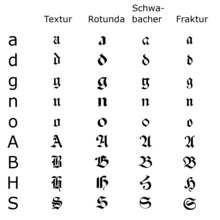Schwabacher

The Schwabacher , also Schwabacher script or old Schwabacher script , is a script from the group of broken scripts . It originated in the 15th century and is coarser, more open and wider than the Gothic Textura . The Schwabacher was the predominant German script from the late 15th century to the middle of the 16th century . It was then largely supplanted by the Fraktur , but remained popular until the 20th century.
Surname
The origin of the name "Schwabacher" is controversial. At the time of its creation, there was no print shop in Schwabach, Franconia . There is also no known typewriter of this name. Presumably the name can be traced back to the Schwabach Articles adopted by the Schwabach Convent in 1529 , which were incorporated into the Confessio Augustana of Protestants in 1530 . “Schwabacher” would therefore be an abbreviation for “Font of the Schwabacher Articles”.
use

The Schwabach script was probably first used by Johann Bämler in an Augsburg cradle print from 1472. It was used in Nuremberg from 1485. Anton Koberger used it there around 1490 for the Schedelsche Weltchronik and Albrecht Dürer in 1498 for the Dürer Apocalypse .
While the Latin Gutenberg Bibles were set in the traditional Textura, the Schwabacher script was used for many editions of the Luther Bible (1522) and its reprints, so that this script was familiar in German-speaking countries for centuries.
From the middle of the 16th century, German-language texts were mainly printed in Fraktur . In Fraktur texts, the Schwabacher was often used to mark fonts until the 20th century . This form of distinction was so common that even highlighting in the handwriting (for example by underlining ) was occupied with the verb "schwabachern".
In 1941 the National Socialists banned the use of broken scripts by authorities and in school lessons. The Schwabacher script and other broken scripts that are frequently used in Germany were defamed as "Schwabacher Jewish letters" in the Ordinance on Normal Scripts. This designation cannot be explained from the history of the development of the Schwabacher script; rather, at the height of the National Socialist War of Conquest, the international usability of the now ordered Antiqua was probably one of the motives for this decision. In the city of Schwabach itself, this term caused incomprehension.
features
The Schwabacher is characterized by a strong rounding (shape) of the letters compared to the Fraktur or Textura. The small o is round on both sides, while in the textura it is angular on both sides and in the fracture it is half round and half angular. Other typical letters are the lowercase g crossed above and the uppercase H. But also with her curves alternate with sharp edges, so that she is rightly counted among the broken scripts. The Schwabacher script is considered a strong, popular script.
literature
- Friedrich Beck : “Schwabacher Judenlettern” - Scripture disapproval in the Third Reich. In: The Art of Networking. Verlag für Berlin-Brandenburg, 2006, ISBN 3-86650-344-X ( pdf ).
- Philipp Luidl: The Schwabacher - The unusual ways of the Schwabacher Jewish letters . Maro Verlag, Augsburg 2003, ISBN 3-87512-415-4 .
- “Forgotten and suppressed” - Schwabach 1918–1945. Exhibition catalog Stadtmuseum Schwabach, p. 172.
Web links
- Alte Schwabacher font family (five TTF fonts) as download (designated as freeware)
- Association for German Writing and Language eV - an overview of the history of writing and an etiquette of Fraktur as a free PDF file
Individual evidence
- ^ Friedrich Schleiermacher , Friedrich Schlegel : Letter to August Wilhelm Schlegel from January 15, 1798. In: Critical Friedrich Schlegel edition. Vol. XXIV. Schöningh, Paderborn u. a. 1985, ISBN 3-506-77824-2 , p. 80.
- ↑ Helmut Heiber : The back of the swastika. Strange things from the files of the Third Reich. Dtv, Munich 1993, ISBN 3-423-02967-6 , p. 224 f.
